If you do
NOT see the Table of Contents frame to the left of this page, then
Click here to open 'USArmyGermany'
frameset |
Ordnance Division
(Page 1 - Doctrinal & General Information)
Looking for more information from military/civilian
personnel assigned to or associated with the U.S. Army
in Germany from 1945 to 1989. If you have any
stories or thoughts on the subject, please contact me . .
|
|
|
|
|
|
| The
1950s |
| |
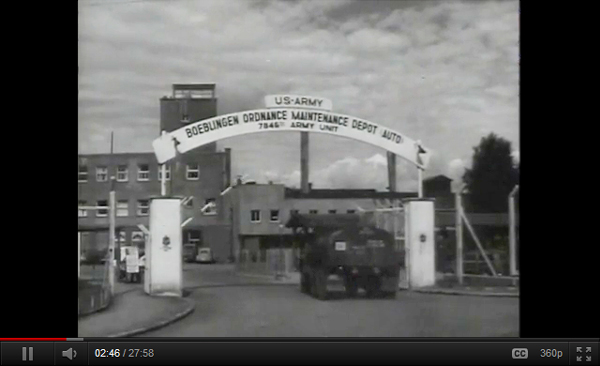
Big Picture Series: Ordnance Corps in USAREUR, mid-1950s (YouTube)  |
|
| Ordnance
- Maintenance & General Supply |
| |
| (Source: FM 9-10,
Ordnance Maintenance and General Supply in the Field, August 1951) |
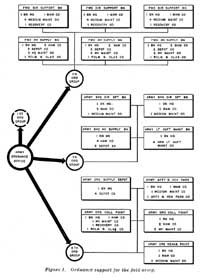 Figure
1: Field Army Level Ordnance Support (1951)
Figure
1: Field Army Level Ordnance Support (1951)
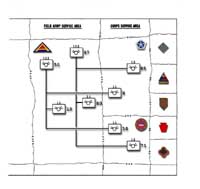
Figure 2: 7th Army Ordnance Organization (Draft)
|
Ordnance
Command Units in the Combat Zone
General
a. The contact of ordnance service with the using organization
is extremely important and provisions have been made to simplify
that contact to a single point for ammunition and another point
for both maintenance and supply. A mobile ordnance maintenance
unit is organic to each division and provides direct support
for the maintenance and supply requirements of all units of
the division. Battalion headquarters and attached mobile ordnance
maintenance companies of army ordnance service provide a direct
support for the maintenance and supply requirements of non-divisional
units in the combat zone. Divisional ordnance maintenance units
and the battalions of army ordnance service charged with providing
direct support of using organizations are referred to as direct support ordnance units.
b. The direct support ordnance units are supported by semimobile
heavy maintenance companies and depot companies. The heavy maintenance
companies accept overflow work from direct support units and
accomplish work requiring more extensive shop equipment. The
depot companies provide a reserve of ordnance general supply,
especially fast moving parts and heavy assemblies. Ordnance
battalions consisting of heavy maintenance companies and depot
companies are referred to as heavy support battalions.
c. Each using organization, whether it be division or nondivisional
receives direct support from a single ordnance company. Each
direct support ordnance unit is supported by a heavy support
ordnance battalion.
d. Further to the rear, additional ordnance battalions are organized
for specific general support missions, such as operation of
the Army Ordnance Supply Depot, the Army Artillery and Vehicle
Park, the Army Ordnance Rehabilitation Point, and the Army Ordnance
Collecting Point.
e. Ordnance service in the field army is normally organized
in four ordnance groups (Figure 1). For discussion purposes
these groups are designated the first, second, third and fourth
ordnance groups. The first ordnance group is concerned with
the supply of ammunition and is discussed in in a separate
section. The second, third and fourth ordnance groups are
concerned with ordnance maintenance and general supply and are
covered in this section. |
|
|
Second Ordnance
Group
The group is responsible for providing direct support for corps
troops and for assisiting the ordnance maintenance companies of
the infantry and airborne divisions.
|
| |
One forward
direct support battalion is assigned the mission
of providing direct support for each corps. The Ord Bn (Fwd)(DS)
consists of one headquarters and headquarters detachment; four
medium maintenance companies; one medium automotive maintenance
company; and one recovery company.
One forward heavy support battalion
supports each forward direct support battalion. The Ord Bn (Hv
Spt) consists of one headquarters and headquarters detachment;
two heavy maintenance companies; two heavy automotive maintenance
company; two depot companies; and one reclamation and classification
company. |
|
| |
Third
Ordnance Group
This group is responsible
for the field maintenance of units located in or passing through the
army service area and for the field maintenance of army aircraft.
|
| |
Two army
service direct support battalions provide direct
support for army troops. Each battalion consists of one headquarters
and headquarters detachment, ordnance battalion; five medium
automotive maintenance companies; and one medium maintenance
company. The entire army service area is divided between these
two direct support ordnance battalions.
One army service heavy support battalion
supports the two army service direct support battalions. This
battalion consists of one headquarters and headquarters detachment,
ordnance battalion; four heavy automotive maintenance companies;
and two depot companies.
Four light aircraft maintenance companies and one headquarters
and headquarters detachment, ordnance battalion are required
for the inspection of organizational maintenance of army aviation,
the replenishment of army aviation spare parts and supplies
consumed in organizational and field maintenance, and the field
maintenance of army aircraft. One light aircraft maintenance
company is located near each corps air-strip and at the army
air-strip. The difference is that army aviation inspection procedures
and maintenance cycles precludes any mixing of army aviation
technical skills with armament or vehicles maintenance personnel
and a distinct organizational structure is preserved. |
|
| |
Fourth Ordnance
Group
This group provides
general support for the field army. |
| |
The army
ordnance supply depot consists of one headquarters
and headquarters detachment, ordnance battalion, and four ordnance
depot companies. This battalion is the port of entry for ordnance
general supplies, except for towed artillery vehicles and army
aircraft.
The army ordnance artillery and vehicle park
consists of one headquarters and headquarters detachment, ordnance
battalion, one artillery and vehicle park company, one medium
maintenance company, and one medium automotive maintenance company.
This battalion is responsible for the receipt, inspection, and
servicing of towed artillery and vehicles required by the army
for replacement purposes.
The army ordnance rehabilitation point
consists of one headquarters and headquarters detachment, ordnance
battalion, two medium maintenance companies; and two medium
automotive maintenance companies. This battalion rehabilitates
the ordnance equipment of organizations withdrawn from combat
for this purpose and may be dispatched to any part of the army
area where its services are required.
The army ordnance collecting point
consists of two battalions of heavy maintenance companies to
inspect, classify, repair, or reclaim unserviceable ordnance
major items, assemblies, subassemblies, and parts, as well as
captured enemy mat6riel of similar types generated in the combat
zone. Two headquarters and headquarters detachments, ordnance
battalion; three heavy maintenance companies; three heavy automotive
maintenance companies; one reclamation and classification company;
and one recovery company constitute two army heavy maintenance
battalions for this purpose. |
|
| |
7th
Army Ord Bns in USAREUR (STATION LIST, 15 Dec 1952):
Fwd DS Ordnance Battalions -
 71st
Ord Bn, Illesheim 71st
Ord Bn, Illesheim
 80th
Ord Bn, Esslingen 80th
Ord Bn, Esslingen
 85th Ord Bn, Oberursel 85th Ord Bn, Oberursel
Fwd Hv Spt Ordnance Battalions -
 8th Ord Bn, Griesheim 8th Ord Bn, Griesheim
 38th Ord Bn, Nellingen 38th Ord Bn, Nellingen
7th Army Ordnance Supply Depot -
 19th Ord Bn, Böblingen 19th Ord Bn, Böblingen
(Webmaster Note: the 38th Ord Bn was redesignated as the 87th Ord Bn in December 1954, and I believe the 80th Ord Bn was replaced in the mid-1950s by the 66th Ord Bn as part of Operation Gyroscope) |
|
| |
Ordnance
Medium Maintenance Company (T/O&E 9-7)
a. Mission.
The ordnance medium maintenance company provides direct support for
combat units in the combat zone, and may be employed on any of the
following missions:
 (1) To augment the
organic divisional ordnance service of infantry divisions and of airborne
divisions. (1) To augment the
organic divisional ordnance service of infantry divisions and of airborne
divisions.
 (2) To provide direct
support for corps troops. (2) To provide direct
support for corps troops.
 (3) To provide direct
support for army heavy artillery, including heavy antiaircraft artillery. (3) To provide direct
support for army heavy artillery, including heavy antiaircraft artillery.
 (4) To rehabilitate
the ordnance equipment of combat units, withdrawn from combat for
short periods, for rest. (4) To rehabilitate
the ordnance equipment of combat units, withdrawn from combat for
short periods, for rest.
 (5) To perform maintenance-in-storage
of the army utility stock of towed artillery and vehicles, held for
replacement purposes. (5) To perform maintenance-in-storage
of the army utility stock of towed artillery and vehicles, held for
replacement purposes.
b. Assignment.
Ordnance medium maintenance companies are attached to ordnance battalion
headquarters on the basis of the density of ordnance equipment encountered
in various parts of the combat zone.
c. Capabilities.
The ordnance medium maintenance company is a mobile ordnance maintenance
company capable of accomplishing the third echelon of maintenance
on all types of ordnance equipment, except army aircraft, found in
the combat zone, and capable of supplying the needs of supported using
organizations for organizational spare parts. Under normal conditions
it is capable of providing direct support for the equivalent of 100
artillery pieces, 100 tanks, and 750-wheel vehicles; with other equipment
such as small arms, optical instruments, electrical fire control systems,
and trailers in the proportions normally experienced in the combat
zone.
d. Organization.
The ordnance medium maintenance company includes a supply section,
a service section, and a recovery section, organized into one platoon;
an automotive platoon, and an armament platoon. A signal corps radio
repair detachment may be attached to this company when the amount
of radio equipment to be repaired incident to field maintenance justifies
such an arrangement. |
|
| |
Ordnance Medium Automotive Maintenance Company (T/O&E 9-127)
a. Mission.
The mission of the ordnance medium automotive maintenance company
is to provide direct support to service units and combat support units
in the combat zone, and may be employed in any one of the following
missions:
 (1) To provide direct
support for corps service troops. (1) To provide direct
support for corps service troops.
 (2) To provide direct
support for army service troops. (2) To provide direct
support for army service troops.
 (3) To rehabilitate
the ordnance equipment of service troops during rest periods. (3) To rehabilitate
the ordnance equipment of service troops during rest periods.
 (4) To combat load
and to perform maintenance-in-storage of the army utility stock of
general purpose vehicles, held for replacement purposes. (4) To combat load
and to perform maintenance-in-storage of the army utility stock of
general purpose vehicles, held for replacement purposes.
b. Assignment.
Ordnance medium automotive maintenance companies are attached to ordnance
battalion headquarters on the basis of the density of wheel vehicles
encountered in various parts of the combat zone.
c. Capabilities.
The ordnance medium automotive maintenance company is a mobile ordnance
maintenance company capable of accomplishing the third echelon of
maintenance on wheel vehicles and small arms of service units and
combat support units in the combat zone, and capable of supplying
the needs of supported using organizations for organizational spare
parts. Under normal conditions, it is capable of providing direct
support for the equivalent of 1,500 wheel vehicles, and the small
arms normally encountered in service units and combat support units
of the combat zone. In assessing the capabilities of the medium automotive
maintenance company, the trucks of engineer dump truck companies and
transportation corps truck companies are considered as requiring twice
the field maintenance work normally required by vehicles of that weight
classification in other units.
d. Organization.
The ordnance medium automotive maintenance company consists of a company
headquarters, a supply section, a service section, and a small arms
section, organized into one platoon; and two identical automotive
maintenance platoons. |
|
| |
Ordnance Heavy Maintenance Company (Army)
(T/O&E 9-9)
a. Mission.
The ordnance heavy maintenance company (army) reinforces and assists
the divisional ordnance units and ordnance medium maintenance companies
by accepting work beyond these units' capabilities, either because
of the extent of the work required, or due to lack of time, manpower,
or space or because of the tactical situation. This company performs
field maintenance on small arms, artillery, instruments, and tracked
or combat vehicles.
b. Assignment.
Ordnance heavy maintenance companies are attached to ordnance battalion
headquarters on the basis of the density of ordnance equipment encountered
in various parts of the combat zone.
c. Capabilities.
The ordnance heavy maintenance company is a semi-mobile ordnance maintenance
company capable of accomplishing the third and fourth echelons of
maintenance on all types of ordnance equipment, except army aircraft
and wheel vehicles, found in the combat zone. Under normal conditions,
one heavy maintenance company can provide heavy support for one armored
division; three infantry divisions; or the corps troops of one corps.
The tank platoon of the ordnance heavy maintenance company is designed
to work on track vehicles. The individual repairmen, however, are
all qualified in the maintenance of wheel vehicles before they specialize
in track vehicles. If provision is made for the supply of assemblies
and parts for wheel vehicles, the ordnance heavy maintenance company
can be employed in the field maintenance of wheel vehicles. The ordnance
heavy maintenance company may also be employed in the depot maintenance
of all types of ordnance equipment, except army aircraft, in a theater
where depot maintenance battalions are not provided. This employment
is advantageous when fixed shop buildings are not available and new
construction is impractical, such as during the early stages of an
operation or in a theater where a fixed depot system will not be established.
Employment of ordnance maintenance companies in lieu of depot maintenance
battalions will necessitate the issue of some depot maintenance tools
and the supply of parts required for the fifth echelon of maintenance.
The arrangement for the supply of additional tools and parts to enable
the ordnance heavy maintenance company to engage in the fifth echelon
of maintenance is an operational project which requires approval by
the Theater Army Ordnance Officer.
d. Organization.
The ordnance heavy maintenance company consists of a supply section
and a service section organized into one platoon; an armament platoon;
and a tank platoon. |
| |
Ord
HM units in USAREUR (STATION LIST, 15 Dec 1952):
88th Ord Co (HM)(Army), Sandhofen
301st Ord Co (HM)(Army), Illesheim
304th Ord Co (HM)(Army), Hanau
357th Ord Co (HM)(Army), 38th Ord Bn, Nellingen
517th Ord Co (HM)(Army), Karlsruhe |
|
| |
Ordnance Heavy Automotive Maintenance Company
(T/O&E 9-197)
a. Mission.
The ordnance heavy automotive maintenance company accomplishes field
maintenance of wheel vehicles and trailers, when the scope of maintenance
work required is beyond the capabilities of direct support ordnance
maintenance units in the combat zone.
b. Assignment.
Ordnance heavy automotive maintenance companies are attached to ordnance
battalion headquarters on the basis of the density of ordnance equipment
encountered in various parts of the combat zone.
c. Capabilities.
The ordnance heavy automotive maintenance company is a semi-mobile
ordnance maintenance company capable of accomplishing the third and
fourth echelons of maintenance on wheel vehicles. Under normal conditions,
one heavy automotive maintenance company can provide heavy support
for a combat force in an area containing 4,500 wheel vehicles, exclusive
of trailers. The ordnance heavy automotive maintenance company may
also be employed in the depot maintenance of wheel vehicles in a theater
where depot maintenance battalions are not provided. This employment
is advantageous when fixed shop buildings are not available and new
construction is impractical, such as during the early stages of an
operation or in a theater where a fixed depot system will not be established.
Employment of ordnance heavy automotive maintenance companies in lieu
of depot maintenance battalions will necessitate
the issue of some depot maintenance tools and the supply of parts
required for the fifth echelon of maintenance. The arrangement for
the supply of additional tools and parts to enable the ordnance heavy
automotive maintenance company to engage in the fifth echelon of maintenance
is an operational project which requires approval by the Theater Army
Ordnance Officer.
d. Organization.
The ordnance heavy automotive maintenance company consists of a company
headquarters; a service section and a supply section organized into
one platoon; amd an automotive platoon. |
| |
Ord
HAM units in USAREUR (STATION LIST, 15 Dec 1952):
504th Ord Co (HAM), 38th Ord Bn, Nellingen
507th
Ord Co (HAM), 8th Ord Bn, Griesheim Ordnance Depot
519th Ord Co (HAM), Kaiserslautern
881st Ord Co (HAM), 8th Ord Bn, Hanau
903rd Ord Co (HAM), 38th Ord Bn, Nellingen |
|
| |
Ordnance Depot Company
(T/O&E 9-57)
a. Mission.
The ordnance depot company (Army) receives, stores, and issues Class
II and IV ordnance general supplies and equipment, except towed
artillery and vehicles, used by an army in the field.
b. Assignment.
Ordnance depot companies (army) are attached to ordnance battalion
headquarters on the basis of the density of troops to be supplied
and type of major items of equipment to be serviced.
c. Capabilities.
The ordnance depot company (army) is a semi-mobile unit which can
lift approximately 170 tons of ordnance general supplies per day in
the semi-trailer vans and cargo trucks authorized the company. While
it can lift this tonnage, it cannot displace in one serial because
of the limited number of truck-tractors provided.
d. Organization.
The ordnance depot company consists of one depot platoon and one storage
platoon.
e. 0perations. |
| |
(1) Ordnance
depot companies (army) are normally grouped into two
echelons in the combat zone. The rear echelon may
consist of several ordnance depot companies attached to an ordnance
battalion headquarters (Webmaster Note: in Germany, the
19th Ord Bn) and
assigned the mission of operating the army
ordnance general supply depot (Webmaster Note: Böblingen Ordnance Depot).
This depot serves as a single port of entry for all ordnance
general supplies (except towed artillery and vehicles) received
by the army. Normally, ordnance depot companies assigned to
this depot will be given responsibility for one or more commodity
groups. When four ordnance depot companies are employed on this
mission commodity groups may be assigned as follows:
 (a) Ordnance
SNL Groups A, B, C, D and F. (a) Ordnance
SNL Groups A, B, C, D and F.
 (b) Ordnance
SNL Group G-2 to 500, Inclusive (except G-27). (b) Ordnance
SNL Group G-2 to 500, Inclusive (except G-27).
 (c) Ordnance
SNL Group G-501, etc. (c) Ordnance
SNL Group G-501, etc.
 (d) Ordnance
SNL Groups G-27, H, J, K, L and miscellaneous. (d) Ordnance
SNL Groups G-27, H, J, K, L and miscellaneous. |
| |
(2) The
forward echelon of ordnance depot companies (Webmaster Note:
in Germany, the three forward echelon depot companies - 33rd,
77th and 354th - were attached to the forward direct support
ordnance battalions) are those companies attached to the forward
heavy support battalions. These ordnance depot companies replenish
ordnance general supplies (except towed artillery and vehicles)
consumed by the division ordnance maintenance units and the
army ordnance maintenance companies. Normally, two ordnance
depot companies will be located in close proximity to each other
to support a single corps. Assignment of missions along the
lines of commodity groups is not advisable for forward echelon
depot companies because of the probability of transfers of these
companies between armies. However, if a number of armored divisions
are grouped for an operation of considerable magnitude, it may
be desirable to require one or more ordnance depot companies
to stock parts pertaining to the type of ordnance equipment
involved to insure a highly specialized supply service for the
operation. |
| |
(3) Ordnance
depot companies must retain their identity as separate companies,
so they can be transferred between battalions and armies as
required. Normally, stock record cards are kept on the van with
the supplies to which they pertain and stock records clerks
are detailed to storage groups as required. There are three
practical reasons for this: |
| |
| (a) |
Storage
group chiefs become thoroughly familiar with all aspects
of supply pertaining to their group. A degree of specialization
is attained which facilitates interchangeability and improvision. |
| (b) |
The
risk of neutralizing the ordnance depot company through
the loss of all the stock record cards as a result of
enemy action is minimized. The loss of a part of the ordnance
depot company will not jeopardize the operation of the
entire company. |
| (c) |
The
necessity for maintaining both stock record cards and
locator cards is eliminated, thereby reducing an additional
possibility for error between stock record cards and the
stock actually on hand. |
|
| |
(4) If
centralized operation of the stock records sections of the depot
companies is desired, the stock records sections may be assembled
under the supervision of the battalion ordnance general supply
officer, but should retain their identity as separate working
sections. If it is deemed essential to assemble stock records
cards in a central location, then locator cards must be prepared
and held in each storage section by storage group chiefs. |
| |
(5)
The depot company, if fully supplied with all authorized supply,
may have from 200 to 600 tons of ordnance general supplies in
its custody. Operating procedures must provide for fast-moving
essential supplies to be loaded in vans and for pooling available
truck-tractors of other units to make it possible to go out
of action late one day, displace during the night, organize
new position, and be ready for operations early the next day.
Supplies are brought up as rapidly as possible, utilizing pooled
transportation of other units, especially ordnance recovery
companies and army transportation corps truck companies. |
| |
(6) The
ordnance depot company will have in its custody a large stock
of sensitive major items such as small arms, binoculars, and
watches. Exceptional care must be exercised in the custody,
security, and accounting for these items. A separate storage
group, under a specially selected storage group chief is frequently
desirable. |
|
| |
Ord
Depot units in USAREUR (STATION LIST, 15 Dec 1952):
33rd Ord Co (Depot)(Army), 85th Ord Bn, Oberursel
40th Ord Co (Depot)(Army), 19th Ord Bn, Böblingen
63rd Ord Co (Depot)(Army),
19th Ord Bn, Böblingen
77th Ord Co (Depot)(Army), 80th Ord Bn, Esslingen
78th Ord Co (Depot)(Army), 19th Ord Bn, Böblingen
334th Ord Co (Depot)(Army), 71st Ord Bn, Illesheim
978th Ord Co (Depot)(Army), 19th Ord Bn, Böblingen |
|
| |
Ordnance Recovery Company (T/O&E 9-187)
a. Mission.
The ordnance recovery company augments the evacuation facilities of
combat units and combat support units in the combat zone. The company
operates a pool of recovery equipment to provide for battlefield recovery
and evacuation of ordnance equipment.
b. Assignment.
Ordnance recovery companies are attached to ordnance battalion headquarters
on the basis of the number of ordnance collecting points to be established.
c. Capabilities.
The ordnance recovery company is a mobile unit capable of providing
recovery and evacuation facilities for an ordnance collecting point,
which is located near the corps rear boundary or in the army service
area.
d. Organization.
The ordnance recovery company consists of a company headquarters and
three identical recovery platoons. |
| |
(1) The
company headquarters consists of the headquarters, an operations
and reconnaissance section, and a service section. The operations
and reconnaissance section include the operations, reconnaissance,
clerical, and communications personnel necessary to locate,
inspect, and record disabled and abandoned ordnance equipment
and captured enemy equipment. This section furnishes information
to the headquarters section or recovery platoons to enable appropriate
recovery equipment to be dispatched. Radios are mounted on light
trucks to provide reconnaissance parties with communication
with the recovery platoons when telephone communication is not
available. The service section includes the dispatcher, organizational
mechanics, welder; and armorer necessary to dispatch vehicles
and perform organizational maintenance on the company vehicles
and armament. |
| |
(2) Recovery
platoon. Each of the three recovery platoons is capable of functioning
separately for a limited period of time when augmented by food
service and administrative personnel from the company headquarters
section. An explosive ordnance disposal specialist is included
in each recovery platoon for the purpose of neutralizng booby
traps or mines that might be encountered in recovery operations.
A tank recovery vehicle and several semitrailer transporters,
truck tractors, wreckers, cargo trucks, light trucks, and trailers
are provided in each recovery platoon for transporting special
tools and equipment, supplies, personnel, and unserviceable
ordnance equipment recovered or evacuated by the platoon. Radios
are provided in light trucks to provide reconnaissance parties
with means of communication when telephone communication is
not available. |
|
| |
| e. Operations. |
| |
(1) Using
organizations have primary responsibility for the recovery and
evacuation of unserviceable or abandoned ordnance equipment.
The ordnance recovery company assists the using organization
by performing recovery and evacuation operations beyond the
capabilities of the using organization. The ordnance company
should not be required, or permitted, to assume the responsibility
of the using organization for this function. Requests for assistance
in battlefield recovery are made by the using organization to
the ordnance maintenance company charged with direct support.
Such requests are either passed on to battalion headquarters
or directly to the recovery company. |
| |
(2) The
ordnance recovery company performs organizational maintenance
of its own equipment. Field maintenance support will normally
be furnished by an ordnance medium maintenance company attached
to the same battalion. |
| |
(3) Each
recovery platoon will be prepared to operate separately and
to accomplish its own reconnaissance. Operating procedures will
provide for the security and defensive measures will be taken
by recovery crews when operations must be conducted under fire. |
| |
(4) Recovered
ordnance equipment will be evacuated to ordnance collecting
points. |
| |
(5) When
not actually required for recovery operations, the recovery
company may be required to assist ordnance depot companies and
heavy maintenance companies in displacing forward by transporting
some of their heavy assemblies. Tank transporters will normally
haul heavy supplies and all orders dispatching transporters
over the road should include instructions relative to loads
to be hauled. |
|
| |
Ord
Recovery units in USAREUR (STATION LIST, 15 Dec 1952):
460th Ord Co (Recovery), Sandhofen |
|
| |
Ordnance Reclamation and Classification Company (T/O&E 9-167)
a. Mission.
The ordnance reclamation and classification company operates ordnance
collecting points in the combat zone.
b. Assignment.
Ordnance reclamation and classification companies are attached to
ordnance battalion headquarters to operate ordnance collecting points
near the corps rear boundary or in the army service area.
c. Capabilities.
The ordnance reclamation and classification company is a semi-mobile
unit capable of operating a collecting point for the receipt, inspection,
classification, and segregation of unserviceable ordnance general
supplies and similar captured enemy materiel, normally generated by
a corps in combat. It performs minor repairs to ordnance general supplies,
including the sectional repair of tires and tubes, preserves and prepares
items of ordnance general supply for evacuation when major repairs
are required, and disposes of the unserviceable residue.
d. Organization. The ordnance reclamation and classification company
consists of a reclamation and classification platoon and a supply
and evacuation platoon. |
| |
(1) The
reclamation and classification platoon consists of armament
and automotive repairmen and tire rebuilders. |
| |
(2) The
supply and evacuation platoon consists of supply specialists
to record, pack, and ship all serviceable or reclaimed items
to designated ordnance general supply installations, and to
preserve and package unserviceable but repairable items for
shipment to designated field and depot maintenance installations;
and special vehicle operators to move heavy ordnance equipment
within the ordnance collecting points. |
|
| |
e. Operations.
Operating procedures of the ordnance reclamation and classification
company will provide for |
| |
(1) Classification
and segregation of materiel received at the ordnance collecting
point in accordance with the supply categories previously outlined
in Chapter 1 of FM 9-10. Materiel classified as belonging to
unserviceable group C is further segregated as follows |
| |
| (a) |
Economically
repairable with minimum effort and within capabilities
of the classification and reclamation company. |
| (b) |
Repairable
by supporting heavy maintenance companies. |
| (c) |
Repairable
by depot maintenance units of the communication zone. |
|
| |
(2) Preservation
and preparation of materiel for evacuation to designated ordnance
general supply or maintenance installations in accordance with
priorities established by higher headquarters. |
| |
(3)
Minor repair of the maximum amount of unserviceable equipment,
accessories, and spare parts consistent with the primary mission
of classifying and evacuating materiel to other maintenance
installations to insure that the backlog of unclassified materiel
does not assume unwarranted proportions. |
| |
(4) Repair
and return to stock of tires and tubes requiring single section
repairs and evacuation to tire repair companies of the communications
zone those tires requiring retreading or multiple section repairs. |
|
| |
Ord
R&C units in USAREUR (STATION LIST, 15 Dec 1952):
148th Ord Co (R&C)(Army), Griesheim |
|
| |
Ordnance Artillery and Vehicle Park Company (T/O&E 9-137)
a. Mission.
The ordnance artillery and vehicle park company receives, stores,
and distributes the army utility stock of reserve towed artillery
and vehicles. The company operates a small ammunition supply point
and ration dump for the loading of ammunition and rations on combat
vehicles before issuing them.
b. Assignment.
Ordnance artillery and vehicle park companies are attached to ordnance
battalion headquarters on the basis of the quantity of towed artillery
and vehicles expected to be maintained as army reserve stocks in the
combat zone. Normally, only one company is required per army or independent
corps.
c. Capabilities. |
| |
(1) The
ordnance artillery and vehicle park company is capable of maintaining
a reserve of 100 artillery pieces (including self-propelled)
and approximately 1,000 vehicles, of which 40 per cent are expected
to be combat vehicles. In each 30-day period, the unit is capable
of receiving and distributing approximately twice this quantity
of ordnance equipment. |
| |
(2) In
processing artillery and vehicles for issue and in performing
care and preservation in storage on this ordnance equipment,
the company must be assisted by ordnance field maintenance companies.
Normally, an ordnance battalion, consisting of a battalion headquarters,
an artillery and vehicle park company, and one or more ordnance
medium maintenance and medium automotive maintenance companies,
is charged with the operation of the artillery and vehicle park
for an army in the field. |
|
| |
d. Organization.
The artillery and vehicle park company consists of a park platoon
and a distribution platoon. |
| |
(1) The
park platoon includes the inspection and maintenance section
and the depot section. The inspection and maintenance section
includes the specialists required to perform care and preservation
in storage on items of ordnance equipment which have been processed
by the field maintenance companies. The depot section includes
the supply specialists and ammunition handlers to maintain property
accountability for major items received and issued, to maintain
a stockage of tools and accessories to replace items found to
be missing; and to maintain stocks of rations, ammunition, and
gasoline for use in combat loading vehicles. |
| |
(2) The
distribution platoon includes the personnel and equipment to
deliver artillery and vehicles within the combat zone. |
|
| |
| e. Operations. |
| |
(1) The
artillery and vehicle park company functions as a single "port
of entry" into the army area for artillery and vehicles. Artillery
and vehicles received from the communications zone will be receipted
for and picked up on the stock record cards of the artillery
and vehicle park company. Prior to placing major items in storage,
all items are inspected and a work request and job order is
prepared on materiel which is not in serviceable group A or
B condition. The supporting ordnance maintenance companies are
responsible for performing the maintenance required to place
the major items in serviceable group A or B condition. |
| |
(2) Provisions
will be made for performing care and preservation in storage
on major items and for evacuating items developing deficiencies
beyond the capabilities of the artillery and vehicle park company
to supporting ordnance maintenance companies. |
| |
(3) The
artillery and vehicle park company will maintain a stock of
tools and accessories for replacement of any found missing on
major items received. Stocks of rations, ammunition, and gasoline
for combat loading vehicles will also be maintained. |
| |
(4) Normally,
replacement vehicles and artillery will be delivered to ordnance
maintenance units or to designated using units. However, delivery
may be taken at the artillery and vehicle park if directed by
higher authority. Tank transporters and other transportation
evacuating unserviceable materiel to the rear should be utilized
to effect delivery to forward units whenever possible. |
|
| |
Ord
Arty & Veh Park units in USAREUR (STATION LIST, 15 Dec 1952):
558th Ord Co (Arty-Veh Park), 19th Ord Bn, Böblingen
|
|
| |
| (Source: Keeping
the Guns Battle-Ready, Army Information Digest, Jan 1956. p.
41 - 43.) |
Each infantry
and airborne division normally has an Ordnance battalion
consisting of two (2) companies, while the armored division Ordnance
battalion is composed of three identical companies, plus
a headquarters company.
Normally Ordnance companies work in the Division rear and Corps service
areas but are assigned to Army.
- Direct Support (DS) Ordnance companies
give mobile support for non-divisional troops and reinforce division
ordnance when required.
- Backing up the DS companies at Corps level are Ordnance
Heavy Maintenance (HM) companies (TOE 9-9R) which furnish
repairs too heavy for the DS companies.
- There are also Direct Support companies
in the Army Area to supply and maintain the Army AAA Brigade.
Depot maintenance is centered in the
Communications Zone Area.
Materiel that may be too badly damaged for either DS or HM units to
handle is dispatched to the Ordnance Armament and Fire Control Rebuild
Company of the Ordnance Armament Rebuild Battalion.
In addition there are several Ordnance detachments and teams which
are organized for specific duties.
 - Artillery Repair Detachments for field
artillery repairs - Artillery Repair Detachments for field
artillery repairs
 - Integrated Fire Control Detachments
which provide field maintenace of the M-33 Antiaircraft Fire Control
Systems or T-38 Antiaircraft Fire Control Systems - Integrated Fire Control Detachments
which provide field maintenace of the M-33 Antiaircraft Fire Control
Systems or T-38 Antiaircraft Fire Control Systems
 - Heavy Antiaircraft Artillery Repair Detachment
which performs field maintenance on 75-mm, 90-mm and 120-mm pieces
and mounts only. - Heavy Antiaircraft Artillery Repair Detachment
which performs field maintenance on 75-mm, 90-mm and 120-mm pieces
and mounts only. |
|
| |
| EUCOM Ordnance Division -- Ordnance Construction Program (1950 - 1953) |
| |
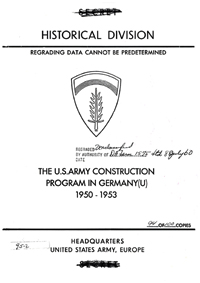 USAREUR Construction Program, 1950-1953
USAREUR Construction Program, 1950-1953 |
|
EUCOM Ordnance Division
With the initiation of the troop augmentation program in 1950, USAREUR launched a construction program in Germany to provide housing and support facilities for the planned increase of US Army troops in theater from 86,000 to over 230,000. April 1950 a
This section covers the construction efforts undertaken to support Ordnance Corps troops in Germany. |
|
|
|
| EUCOM Ordnance Division (1952) -- Ordnance Rebuild Program |
| |
| 1952 |
| (Source: STARS & STRIPES, March 2, 1952) |
EUCOM Chief of Ordnance in 1952 is Brig Gen Ray M. Hare
Currently, one of the primary mission's of the Ordnance Division is the rebuilding of WWII-vintage ordnance materiel for equipping the armies of Allies under the Mutual Defense Assistance Program. In additional to the rebuild program, the Ord Div is also responsible for training (in the EUCOM Ordnance School) officers and men of the MDAP nations in the maintenance of the equipment that they are receiving through the rebuild program.
The Rebuild Program began in May 1947 when
the Ordnance Division was tasked with collect and rehabilitate equipment that had been left in theater when units redeployed to the US after WWII. This surplus equipment was scattered around Germany in depots and vehicle parks. The Ord Div began actual rebuilding operations in 1948. Equipment declared excess of Army needs were channeled through STEG (1) for disposal.
This program is still active and continues to supply rebuilt equipment to both US troops as well as to allied nations under MDAP.
So far (March 1952), the program has rebuilt approximately $1 billion worth of equipment that includes wheeled and tracked vehicles (jeeps, trucks and tanks), artillery, small arms, automatic weapons, tires and tubes, fire-control apparatus, tools and parts. The cost to US taxpayers was less than $100 million. (Returning the equipment to the US for rebuild and then resupply back to the European theater would have cost about $600 million).
Due to the added missions of supporting the MDAP program and the build up of US troops in theater, the Ordnance Division has undergone a major reorganization in the recent past. Four ordnance groups have been formed under the Ord Div to handle the increased load and to maintain operational control of the 20+ ordnance installations in theater:
| |
7848th Ordnance Maintenance Group |
|
Hqs: Esslingen
CO: Col James E. McInerney
operates 13 maintenance shops
|
| |
7847th Ordnance Supply Group |
|
Hqs: Mannheim
CO: Lt Col Frederic E. Hendler
operates 4 supply depots
|
| |
7846th Ordnance Ammunition Group |
|
Hqs: Kaiserslautern
CO: Lt Col Samuel M. Fletcher
operates 5 ammunition depots
|
| |
7841st Ordnance Procurement Group |
|
Hqs: Sandhofen
CO: Col James W. Walters
operates branch offices located in varies European cities
|
|
| |
Ordnance Installations in Germany include:
| |
Butzbach Ordnance Depot |
|
|
| |
Karlsfeld Ordnance Depot |
|
|
| |
Mannheim Ordnance Depot |
|
|
| |
Ordnance Stock Control Center |
|
(Mannheim) |
| |
Ober-Ramstadt Tire Rebuild Shop |
|
|
| |
Pirmasens Ordnance Depot |
|
|
| |
EUCOM Ordnance School |
|
Eschwege |
| |
Rhine Ammunition Depot |
|
Miesau |
| |
Rhine Ordnance Depot |
|
Kaiserslautern |
| |
Germersheim Ordnance Vehicle Park |
|
|
| |
Mainz Ordnance Depot |
|
|
| |
Ordnance Automotive Center |
|
includes the following rebuild shops:
Esslingen Ordnance Depot
Bad Cannstatt Vehicle Park
Aalen Ordnance Depot
Böblingen Ordnance Rebuild Shop
Schwäbisch-Gmünd Ordnance Rebuild Shop
Waiblingen Ordnance Rebuild Shop |
|
| Of note, more than 24,000 Germans are employed by the ordnance depots in Germany. |
| |
Ordnance Installations in France include:
| |
Captieux Ammunition Depot |
|
|
| |
Trois-Fontaines Ammunition Depot |
|
|
| |
Braconne Ordnance Depot |
|
|
| |
Fontenet Ordnance Depot |
|
|
| |
Nancy Ordnance Depot |
|
|
| |
Frescaty Aircraft Service Center |
|
|
| |
St. Hubert Ordnance ?? |
|
|
|
| |
| (1) STEG (Staatliche Erfassungsstelle für öffentliches Gut) is the West German government-controlled agency responsible for the disposal of surplus equipment. |
|
| |
| (Source: STARS & STRIPES, Dec 8, 1953) |
USAREUR Ord Div announced on December 7 that ten ordnance installations have been renamed. Under the new naming system, ordnance installations are classified as either supply or maintenance. Maintenance installations are further broken down as to the type of maintenance performed. (All other ordnance installations remain unchanged.)
The installations renamed are as follows:
|
| |
NEW DESIGNATION |
HIGHER HQS |
|
| |
Esslingen Ord Maintenance Depot (Auto) |
51st Ord Gp |
|
| |
Boeblingen Ord Maintenance Depot (Auto) |
51st Ord Gp |
|
| |
Schwaebisch-Gmuend Maintenance Depot (Auto) |
51st Ord Gp |
|
| |
Karlsfeld Ord Maintenance Depot (Auto) |
51st Ord Gp |
|
| |
Aalen Ord Maintenance Depot (Auto) |
51st Ord Gp |
|
| |
Butzbach Ord Maintenance Depot (Armament) |
51st Ord Gp |
|
| |
Mainz Ord Maintenance Depot (Armament & Fire Control) |
51st Ord Gp |
|
| |
Pirmasens Ord Supply Depot |
53rd Ord Gp |
|
| |
Rhine Ord Supply Depot |
53rd Ord Gp |
|
| |
Mannheim Ord Supply Depot |
53rd Ord Gp |
|
|
|
|
| (Source: STARS & STRIPES, May 14, 1953) |
USAREUR Ordnance 1952/53
On the occasion of the Army Ordnance Corps' 141st Anniversary observance at Spinelli Barracks, Mannheim, Brig Gen Earl S. Gruver, ordnance officer of USAREUR, will inspect the honor guard and then witness a display of ordnance materiel required to supply an infantry regiment, including weapons, ammunition, wheeled and tracked vehicles, tools and fire control instruments.
Guests for the day's activities will include, in addition to Gruver, Col George W. White, deputy ordnance officer for USAREUR, and Lt Col F. E. Hendler, commanding officer of the 53rd Ord Gp.
A parade and review of troops in honor of Gruver will follow the demonstration.
To train manpower in Europe for the technical role of Ordnance is the mission of the USAREUR Ordnance School at Fuessen. Here, both officers and enlisted men as well as personnel of countries taking part in the North Atlantic Treaty Organization and the Mutual Security Administration program receive instruction in subjects ranging from special parts identification to maintenance of the M47 tank.
Another ordnance unit, the 51st Ord Gp, commanded by Col Philip Schwartz, can well be called the Army arsenal in Europe. Into the depots and installations of this group are funneled all the worn and disabled guns, instruments, fire control equipment, wheeled and tracked vehicles and tires.
After being rebuilt and reconditioned, this equipment is put back in use with US forces and NATO nations.
The 53rd Ord Gp processed for shipment more than 100,000 wheeled and tracked vehicles during the past year. The group is located at the Germersheim Ordnance Vehicle Park and the Rhine Ordnance Depot. The Germersheim park was established for vehicle processing in connection with the Mutual Defense Assistance Program.
The ordnance offshore procurement program, administered by the Ordnance Procurement Center under the command of Col Joseph M. Colby, is another of Gruver's responsibilies. |
|
|
| 1954 |
| (Source: STARS & STRIPES, May 11, 1954) |
Reduction of the Army Rebuild Program
The Army's vehicle rebuild program in Europe which was originally initiated to rehabilitate WWII-era vehicles and equipment is now drawing to a close. Two current trends have reduced the need for many of the depots involved in the program:
 1) the last of the WWII-era vehicles and equipment that the US had committed to deliver to its NATO allies under the MDAP program is now rolling off depot assembly lines; 1) the last of the WWII-era vehicles and equipment that the US had committed to deliver to its NATO allies under the MDAP program is now rolling off depot assembly lines;
 2)
most of the rebuild work in the future will be performed by civilian firms under commercial contracts. 2)
most of the rebuild work in the future will be performed by civilian firms under commercial contracts.
By the end of this summer, more than half of the USAREUR ordnance rebuild installations which existed in 1951 will have been closed and turned back to their former German owners.
The Mutual Defense Assistance Program placed a great workload on the USAREUR Ordnance Division. Under MDAP, the division was responsible for rebuilding, processing, and shipping more than 50,000 vehicles and tons of supplies to NATO allies. In the meantime, almost all of the WWII-era rebuilt vehicles have been replaced by newly developed (post-WWII) vehicles.
In September 1951, 14 rebuild shops operated under the 7848th Ord Maint Gp which later became the 51st Ord Gp. Only four of these are scheduled to still be in operation by the end of next year.
Some of the more important shops closed before May 1954 (closed date in parentheses):
 Bad Cannstatt Ord Vehicle Park (Oct 1952) Bad Cannstatt Ord Vehicle Park (Oct 1952)
 Waiblingen Ord Rebuild Shop (June 1953) Waiblingen Ord Rebuild Shop (June 1953)
 Aalen Ord Maint Depot (Feb 1954) Aalen Ord Maint Depot (Feb 1954)
 Esslingen Ord Maint Depot was reduced to a sub-branch of the Boeblingen Depot (Feb 1954) Esslingen Ord Maint Depot was reduced to a sub-branch of the Boeblingen Depot (Feb 1954)
Scheduled shutdowns for the near future (scheduled close date in parentheses):
 Butzbach Ord Maint Depot (May 1954) Butzbach Ord Maint Depot (May 1954)
 Pirmasens Ord Supply Depot (May 1954) Pirmasens Ord Supply Depot (May 1954)
 Rhine Ord Supply Depot (June 1954) Rhine Ord Supply Depot (June 1954)
 Karlsfeld Ord Maint Depot (1955) Karlsfeld Ord Maint Depot (1955)
The four remaining rebuild depots will be located at:
 Schwaebisch Gmuend Schwaebisch Gmuend
 Ober-Ramstadt Ober-Ramstadt
 Boeblingen Boeblingen
 Mainz Mainz
The Mainz and Boeblingen Depots will become the center of rebuild activity for USAREUR, USAFE and USFA.
In addition, there will be two ordnance supply depots in Germany:
 Mannheim Mannheim
 Germersheim Germersheim
Supply operations are being centered in the Com Z.
|
|
|
| EUCOM Ordnance Division (1956) |
| |
| (Source: Telephone Directory, USAREUR Ordnance Division, March 1956) |
| |
|
| |
| Ordnance Maintenance & Supply units in USAREUR (1) |
| (Source: Telephone Directory, USAREUR Ordnance Division, March 1956) |
| 47th ORD GP ORGANIZATION (March 1956): |
|
| |
| 51st ORD GP ORGANIZATION (March 1956): |
|
| (1) Does not include ordnance units in COMZEUR; ordnance ammunition units are listed below. |
|
| |
| FIELD ARMY
LEVEL ORDNANCE UNITS - 1950s |
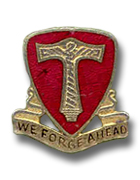 8th
Ord Bn
8th
Ord Bn |
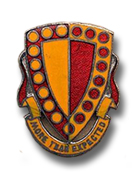 19th
Ord Bn
19th
Ord Bn |
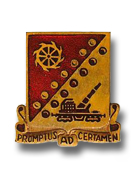 38th
Ord Bn
38th
Ord Bn |
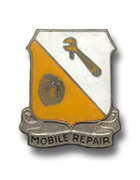 71st
Ord Bn
71st
Ord Bn
|
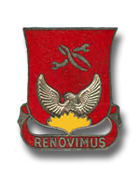
80th Ord Bn |
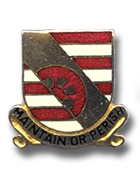
81st Ord Bn |
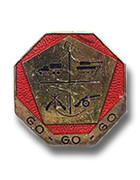
85th Ord Bn |

87th Ord Bn |
|
|
|
| Ordnance
- Ammunition Supply |
| |
| (Source: Telephone Directory, USAREUR Ordnance Division, March 1956) |
| 57th ORD GP (AMMO) ORGANIZATION (March 1956): |
|
| |
| 71st ORD GP (M&S) ORGANIZATION (March 1956): |
UNIT DESIGNATION |
DUTY STATION |
COMMENTS |
| HHC, 71st Ord Gp (Ammo) |
Pirmasens |
APO 289 |
| 9th Ord Bn (Sp Wpns Spt) |
Neckarsulm |
APO 176 |
| 15th Ord Bn (Sp Wpns Spt) |
Weierhof (Kirchheimbolanden) |
APO 227 |
| |
|
|
|
|
| |
Ordnance Procurement
Center
See some history of present day Mannheim
Laboratory Center
|
|
|
| Ordnance - 7th Army Modern Army Supply System (MASS) Project |
| |
| For some of the information on the role of the Ordnance Technical Service in the 7th Army MASS project, see the relevant section on the 19th Ord Bn Page. |
| |
| (More MASS Project information to be added) |
| |
 |
|
|
| The
1960s |
| |
| Class V Ordnance Service in the European Theater |
| |
| (Source: History of the 15th Ordnance Battalion, Adjutant, HQ 15th Ord Bn, 1980s) |
In 1961, a realignment of ordnance support units in Germany, including ammunition units, was effected. Previously, the three Class V ordnance battalions were grouped under 57th Ord Gp (Ammo). In November, the 15th Ord Bn was relieved from attachment to the 57th and attached to the 51st Ord Gp. Similarily, the 101st Ord Bn was relieved (probably in the same time frame) from the 57th and attached to the 47th Ord Gp. The 84th Ord Bn remained attached to the 57th Ord Gp.
At the same time, the mission of the Class V ordnance battalions changed and they became "composite organizations" consisting of conventional and special ammunition companies, as well as supply and maintenance companies.
The 15th Ord Bn unit history goes on to say that the battalion's "composite organization" was soon changed back to a purely ammunition organization (probably in 1963). This is probably true for the other ammo battalions. The battalions, however, remained attached to the "composite" ordnance groups until 1965, when the COSTAR concept was implemented. |
| |
| (Source: STATION LIST, 30 September 1963) |
| CLASS V SUPPORT (COMPANY SIZE) |
| TITLE |
TOE |
UNIT |
COMD |
LOCATION |
|
| Company, Ammunition |
9-17D |
50th Ord Co (Ammo) |
76 |
Rhine Ord Bks, Kaiserslautern |
|
|
|
144th Ord Co (Ammo) |
76 |
Ray Bks, Friedberg |
|
|
|
184th Ord Co (Ammo) |
76 |
Kelly Bks, Darmstadt |
|
|
|
501st Ord Co (Ammo) |
76 |
Rheinland Ksn, Ettlingen |
|
|
|
535th Ord Co (Ammo) |
76 |
D'Isly Ksn, Pirmasens |
|
|
|
571st Ord Co (Ammo) |
76 |
North Point Depot, Kriegsfeld |
|
|
|
663rd Ord Co (Ammo) |
76 |
Rose Bks, Vilseck |
|
|
|
664th Ord Co (Ammo) |
76 |
Strassbourg Ksn, Idar Oberstein |
|
| Company, SW & MSL, DS |
9-47D |
23rd Ord Co |
76 |
Badnerhof Ksn, Heilbronn |
|
|
|
28th Ord Co |
76 |
Turenne Ksn, Zweibrücken |
|
|
|
Co A, 328th Ord Bn |
34 |
Caserma Ederle, Vicenza |
|
|
|
545th Ord Co |
76 |
Ord Ammo Depot, Münster |
|
| Company, SW & MSL, GS |
9-87D |
27th Ord Co (Sp Ammo)(GS) |
03 |
Büren |
|
|
|
70th Ord Co (Sp Ammo)(GS) |
03 |
Corlu, Turkey |
|
|
|
138th Ord Co (Sp Ammo)(GS) |
03 |
Elevsis, Greece |
|
|
|
162nd Ord Co (Sp Ammo)(GS) |
03 |
Lüdenscheid |
|
|
|
510th Ord Co (Sp Ammo)(GS) |
03 |
Urlau |
|
| Company, SW & MSL, Dep |
9-377D |
9th Ord Co |
46 |
Miesau |
|
|
|
64th Ord Co |
46 |
Fischbach |
|
|
|
69th Ord Co (Sp Ammo)(Dep) |
34 |
Caserma Ederle, Vicenza |
|
|
|
525th Ord Co |
46 |
Ord Area, Siegelbach |
|
|
|
529th Ord Co |
46 |
Massweiler |
|
|
|
583rd Ord Co |
46 |
Dahn |
|
|
|
619th Ord Co |
46 |
North Point Depot, Kriegsfeld |
|
|
| CLASS V COMMAND UNITS |
| TITLE |
TOE |
UNIT |
COMD |
LOCATION |
|
| Group, Ammo, HHC |
9-22D |
HHD, 57th Ord Gp (Ammo) |
76 |
Rhine Ord Bks, Kaiserslautern |
|
|
|
HHC, 59th Ord Gp (Ammo) |
46 |
D'Isly Ksn, Pirmasens |
|
| Battalion, Ammo, HHD |
9-86D |
HHD, 15th Ord Bn (Ammo) |
76 |
Gutleut Ksn, Frankfurt |
|
|
|
HHD, 72nd Ord Bn (Ammo) |
46 |
Rhine Ord Bks, Kaiserslautern |
|
|
|
HHD, 84th Ord Bn (Ammo) |
76 |
Rhine Ord Bks, Kaiserslautern |
|
|
|
HHD, 101st Ord Bn (Ammo) |
76 |
Badnerhof Ksn, Heilbronn |
|
|
|
HHD, 193rd Ord Bn (Ammo) |
46 |
Neureut Ksn, Karlsruhe |
|
|
COMMAND CODES
| |
03 |
Special Ammunition Support Command, USAREUR |
| |
34 |
Southern European Task Force |
| |
46 |
4th Logistical Command (COMZ) |
| |
76 |
Seventh Army Support Command |
|
| |
 Figure 1: Class V Ordnance Service (1959)
Figure 1: Class V Ordnance Service (1959) |
Source: FM 9-1, Ordnance Service in the Field, June 1959 |
|
|
| |
| (Source: Email from Rick Anders, Germany) |
| As already mentioned on different pages of this web site, Rick is doing research on various topics relating to French units stationed in Germany. His investigations have led him to many different governmental archives in France and Germany. As a courtesy, he has provided to this web site many tidbits of information that pertain to the US Army in Germany that he finds as part of his efforts. |
| |
Found something about the 47th Ord Gp you might be interested in. The following information is from 1962.
The 47th Ord Gp at Stuttgart has responsibility for 13 ammunition storage sites in Baden-Württemberg and eight in Bavaria (including Bamberg). Those in B-W are at: |
| |
LOCATION |
OPERATING UNIT |
COMD |
DESIGNATION/SITE |
| |
Wertheim |
. |
|
at Grünewörth, west of the airfield; PSP 6J |
| |
Böblingen |
. |
|
PSP 25 |
| |
Schwäbisch Hall |
. |
|
(possibly PSP 26) (MUNA Kupfer?) |
|
Bad Mergentheim |
. |
|
PSP 27J |
|
Schwäbisch-Gmünd |
. |
|
at Waldstetten (possibly PSP 28) |
|
Ellwangen |
. |
|
at Wört |
|
Lampertheim |
. |
|
|
|
Merklingen |
. |
|
(possibly PSP 81) |
|
Crailsheim |
. |
|
(possibly PSP 82) |
|
Bruchsal |
. |
|
at Kammerforst; RASP 971 |
|
Friedrichstal |
. |
|
at Hochstetten |
|
Siegelsbach |
. |
|
|
|
Hockenheim |
. |
|
at the time this storage site did not conform to NATO regulations and was recommended for closure by the 47th |
| |
|
|
|
|
|
| |
| The 51st Ord Gp at Mannheim had eight or nine sites in Hesse. |
| |
| The 57th Ord Gp at Kaiserslautern had five sites in Rhineland-Palatinate and the Saarland. |
| |
Webmaster Note: Will work on getting the 51st and 57th sites identified and creating a list for each of the Ord Groups.
Will also work on identifying which sites were being operated by which ordnance ammo companies in the 1960s (see list above). Will be happy to receive help from anybody who might know some of these details.
MISCELLANEOUS INFORMATION:
Miesau Depot Activity ABREST
Pirmasens Depot Activity ABREST
PSP Koeppern (German: Munitionsdepot Wehrheim-Rosbach) became operational in 1952 and was handed over to the Bundeswehr in 1997
PSP Bernbach (German: Munitionsdepot Freigericht-Bernbach) |
|
|
| Ordnance - Special Weapons Support |
| |
| Nuclear-capable artillery in NATO - 1965 |
|
| |
| Nuclear Ammunition Storage |
| (Sources: "The Elegibility for Infrastructure Funding of Certain Projects in MC 32/11," a Standing Group Report, SG 137/54, 25 August 1958, courtesy Historical Office, SHAPE (NATO Archives website), accessed June 28 2019) |
| Description of Nuclear Ammunition Storages |
1. Storage for nuclear weapons must be provided in magazines capable of providing protection from the elements and from attack. Maintenance must be carried out in special buildings at storage sites and at rearward support and depot installations. Security requirements will dictate the use of fencing, floodlights, guard towers, and alarm devices etc.
2. There will be, in general, three echelons of infrastructure facilities necessary to support the fully implemented NATO nuclear stockpile concept,
  a. Custodial storage sites, or "basic load sites". One of these sites will be located near each unit or group of units having an atomic delivery capability. This basic site will consist of a double fenced enclosure in which storage facilities and a maintenance building are located. Storage facilities will consist of one or more ammnnition magazines of the semi-buried, or cut-and-cover type. The size of the basic site will vary depending on the nature of the atomic delivery unit supported. (Rough estimate of cost for a typical unit of this type is £ 500,000). a. Custodial storage sites, or "basic load sites". One of these sites will be located near each unit or group of units having an atomic delivery capability. This basic site will consist of a double fenced enclosure in which storage facilities and a maintenance building are located. Storage facilities will consist of one or more ammnnition magazines of the semi-buried, or cut-and-cover type. The size of the basic site will vary depending on the nature of the atomic delivery unit supported. (Rough estimate of cost for a typical unit of this type is £ 500,000).
  b. The second echelon of infrastructure facilities will be the support sites. These will contain several magazines for weapons awaiting repair or reissue. A maintenance building larger than that at the basic site will be required. One or more storage buildings for spare parts will be needed. Security fence, guard posts, etc. will be similar to those in the basic sites. (Rough estimate of cost for a typical nnit of this type is £ 400,000). b. The second echelon of infrastructure facilities will be the support sites. These will contain several magazines for weapons awaiting repair or reissue. A maintenance building larger than that at the basic site will be required. One or more storage buildings for spare parts will be needed. Security fence, guard posts, etc. will be similar to those in the basic sites. (Rough estimate of cost for a typical nnit of this type is £ 400,000).
  c. The third echelon of infrastructure facilities will be the depot sites. These will contain, in addition to storage magazines, the necessary shop space for high order maintenance and weapons modification operations. Security fencing and guard posts will be required. (Rough estimate c. The third echelon of infrastructure facilities will be the depot sites. These will contain, in addition to storage magazines, the necessary shop space for high order maintenance and weapons modification operations. Security fencing and guard posts will be required. (Rough estimate
of cost for a typical unit of this type is £ 2 million).
3. Small units of US personnel will be required to carry out maintenance, custody, and assembly operations at the basic, support and depot sites. Where administrative facilities to accomodate these personnel are not available at the storage site, such facilities are a proper charge against common infrastructure funding, in the same manner as they are provided at Early Warning Sites. Such facilities will be required since it is probable that many stockpile sites will be located in areas remote from other installations and facilities. A rough estimate of cost for administrative facilities would be £ 1,000 per man, in addition to the above.
4. It will be necessary to provide adequate and reliable communications facilities (radio and land line) in order to:
  a. accomplish the desired control from SACEUR (and his designated Subordinate Commands) to delivery sites and delivery forces. a. accomplish the desired control from SACEUR (and his designated Subordinate Commands) to delivery sites and delivery forces.
  b. provide for administrative and logistic support between rearward and forward echelons. b. provide for administrative and logistic support between rearward and forward echelons.
  c. provide liaison between advanced echelons and supported NATO delivery forces. c. provide liaison between advanced echelons and supported NATO delivery forces.
  d. provide means for reporting between US custodians at basic load sites to nuclear weapons accounting agencies. d. provide means for reporting between US custodians at basic load sites to nuclear weapons accounting agencies.
5. To accomplish these functions, infrastructure requirements will include the construction of extensions to national PTT systems and the provision of telephone, teletype and cryptographic equipment as required. |
|
| |
| Nuclear Ammunition Storage Types |
| |
| |
| |
|
| |
| (Source: German Bundesarchiv, via Rick Anders) |
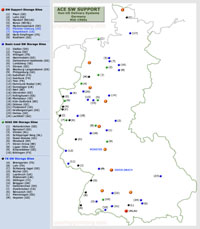 SW Storage Sites in Germany SW Storage Sites in Germany |
. |
|
| |
| (Sources: NATO Strategy Documents, 1949-1969, Historical Office, SHAPE, 1997; Die Anfangsjahre des Heeres, 1956-1966, Special Issue #5002, Tankograd Militärfahrzeug, 2003; War Without Battles, Canada's NATO Brigade in Germany, 1951-1993, by Sean M. Maloney, 1997) |
SHIELD AND SWORD
In 1958, a plan - called MC 70 - was developed by NATO to restructure forces committed to ACE, based on the 1957 strategic concept (MC 14/2). The plan entailed integrating nuclear delivery systems into the "Shield" forces (1), thus making available to NATO members a range of nuclear-capable tube artillery (M-110), short range and medium range surface-to-surface missiles (HJ; Sergeant; Corporal) and nuclear-tiped anti-aircaft missiles (NIKE-H).
A result of this was the creation in 1958 of a stockpile of US nuclear warheads available to NATO members who at the same time acquired the appropriate delivery systems. The American-owned weapons could only be released on the order of SACEUR. |
|
| |
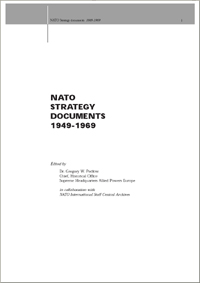 NATO Strategy Documents NATO Strategy Documents
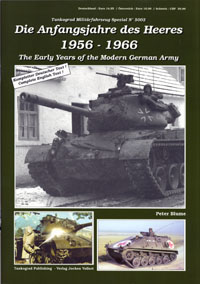 Militärfahrzeug Special Militärfahrzeug Special
Issue #5002
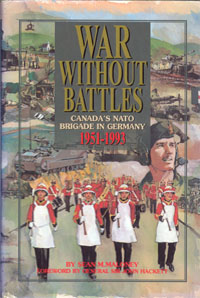 War Without Battles cover War Without Battles cover
|
MC 70 FORCE STRUCTURE
NORTHAG
I (NE) Corps
I (GE) Corps
By the end of 1959, the German corps and divisions had been reorganized under Heeresstruktur 2 ("Division 59"). The artillery at corps and division levels were equipped with the modern M-110 203mm SP howitzers (dual-capable), the non-nuclear M-107 175mm SP howitzers and the Honest John rockets.
Each corps artillery command (ArtKdo) included an HJ-equipped rocket artillery battalion (RakArtBtl) (1) and a field artillery battalion (FArtBtl) (2). The HJ units would later be transferred to divisional artillery regiments, once the new Sergeant missile system was available. By 1964, three Sergeant missile battalions had been formed under the three artillery commands (2).
Each divisional artillery regiment
included a field artillery battalion (two 175mm batteries, one 203mm battery) and a rocket artillery battalion (three HJ batteries).
(1) RakArtBtl 140 at Nienburg; RakArtBtl 240 at Ingolstadt; RakArtBtl 340 at Gießen.
(2) Each FArtBtl comprised two medium (175mm) and one heavy (203mm) firing battery.
(3)
RakArtBtl 150 at Wesel; RakArtBtl 250 at Großengstingen; RakArtBtl 350 at Montabaur. A fourth missile battalion, RakArtBtl 650, was formed at Flensburg and assigned as an asset of the LANDJUT Corps in Schleswig Holstein.
I (BR) Corps
I (BR) Corps nuclear assets by 1960 included three artillery regiments (24 Missile Regiment, RA,
Assaye Bks, Nienburg (4); 39 Missile Regiment, RA, Dempsey Barracks, Sennelager; and 50 Missile Regiment, RA,
Northumberland Barracks, Menden) each comprised of two HJ batteries and two 8in howitzer batteries. Two batteries of 8in guns were allocated to each of the British divisions in I Corps, while the HJ rockets were held at Corps level.
In addition to the afore-mentioned Missile Regiments, I Corps also had a Guided Weapons regiment, 47 Regiment, consisting of two firing batteries equipped with the Corporal missile (one launcher to each battery). This unit was located at Napier Barracks, Dortmund. Two Corporal launchers were held at Army Group (NORTHAG) level.
In 1961, a second Guided Weapons regiment (24 Regiment) was added to the Corps Artillery assets. Arriving from the UK, this unit was also stationed at Napier Barracks.
(4) The regiment moved to
Barker Barracks, Paderborn, in 1962.
I (BE) Corps
|
|
|
|
| Ordnance - TOEs activated or reorganized under the COSTAR Concept |
| |
| (Source: FM 101-10-2 Extracts of Tables of Organization and Equipment, January 1965 with Change 1) |
Click on  thumbnails to view additional details on particular TOE's thumbnails to view additional details on particular TOE's |
| |
(STATION LIST, 30 September 1966)
TOE 29-134F / Light Equipment GS Maintenance Company
78th Lt Equip GS Mnt Company, Panzer Ksn, Boeblingen
81st Lt Equip GS Mnt Company, Sullivan Bks, Mannheim
91st Lt Equip GS Mnt Company, Pulaski Bks, Kaiserslautern
182nd Lt Equip GS Mnt Company, W.O. Darby Ksn, Fuerth
881st Lt Equip GS Mnt Company, Hessen-Homburg Ksn, Hanau
TOE 29-137F / Heavy Equipment GS Maintenance Company
42nd Hvy Equip GS Mnt Company, W.O. Darby Ksn, Fuerth
43rd Hvy Equip GS Mnt Company, Daenner Ksn, Kaiserslautern
66th Hvy Equip GS Mnt Company, Harvey Bks, Kitzingen
77th Hvy Equip GS Mnt Company, Gerszewski Bks, Knielingen
88th Hvy Equip GS Mnt Company, Pioneer Ksn, Hanau
124th Hvy Equip GS Mnt Company, Nellingen
507th Hvy Equip GS Mnt Company, Grossauheim Ksn, Hanau
517th Hvy Equip GS Mnt Company, Tompkins Bks, Schwetzingen
543rd Hvy Equip GS Mnt Company, Pioneer Ksn, Hanau
572nd Hvy Equip GS Mnt Company, Wharton Bks, Heilbronn
903rd Hvy Equip GS Mnt Company, Nellingen
TOE 29-139F / Collection, Classification and Salvage Company
296th Col Cls-Salv Company, Hutier Ksn, Hanau - read more
508th Col Cls-Salv Company, Pulaski Bks, Kaiserslautern
538th Col Cls-Salv Company, Nellingen - read more
TOE 29-136F / Maintenance GS Battalion - 
Hq & Hq Det, 8th Maint Bn (GS), Grossauheim Ksn, Hanau - read more
Hq & Hq Det, 81st Maint Bn (GS), Taylor Bks, Mannheim - read more
Hq & Hq Det, 87th Maint Bn (GS), Nellingen Ksn, Nellingen - read more
TOE 29-205F / Maintenance DS Battalion - 
Hq & A Co (Main Spt), 1st Maint Bn (DS), Ludendorff Ksn, Kornwestheim - read more
 B Co (Lt Maint), 1st Maint Bn, Eastman Bks, Dachau B Co (Lt Maint), 1st Maint Bn, Eastman Bks, Dachau
 C Co (Lt Maint), 1st Maint Bn, Artillery Ksn, Neckarsulm C Co (Lt Maint), 1st Maint Bn, Artillery Ksn, Neckarsulm
 D Co (Lt Maint), 1st Maint Bn, Flak Ksn, Ludwigsburg D Co (Lt Maint), 1st Maint Bn, Flak Ksn, Ludwigsburg
Hq & A Co (Main Spt), 19th Maint Bn (DS), Pendleton Bks, Giessen - read more
 B Co (Lt Maint), 19th Maint Bn, Camp Pieri, Wiesbaden B Co (Lt Maint), 19th Maint Bn, Camp Pieri, Wiesbaden
 C Co (Lt Maint), 19th Maint Bn, Downs Bks, Fulda C Co (Lt Maint), 19th Maint Bn, Downs Bks, Fulda
Hq & A Co (Main Spt), 51st Maint Bn (DS), Sullivan Bks, Mannheim - read more
 B Co (Lt Maint), 51st Maint Bn, Gerszewski Bks, Knielingen B Co (Lt Maint), 51st Maint Bn, Gerszewski Bks, Knielingen
 C Co (Lt Maint), 51st Maint Bn, Spinelli Bks, Mannheim C Co (Lt Maint), 51st Maint Bn, Spinelli Bks, Mannheim
Hq & A Co (Main Spt), 66th Maint Bn (DS), Rhein Ord Bks, Kaiserslautern - read more
 B Co (Lt Maint), 66th Maint Bn, Rhein Ord Bks, Kaiserslautern B Co (Lt Maint), 66th Maint Bn, Rhein Ord Bks, Kaiserslautern
 C Co (Lt Maint), 66th Maint Bn, Smith Bks, Baumholder C Co (Lt Maint), 66th Maint Bn, Smith Bks, Baumholder
Hq & A Co (Main Spt), 71st Maint Bn (DS), Pinder Ksn, Zirndorf - read more
 B Co (Lt Maint), 71st Maint Bn, Conn Bks, Schweinfurt B Co (Lt Maint), 71st Maint Bn, Conn Bks, Schweinfurt
 C Co (Lt Maint), 71st Maint Bn, Ammo Depot, Bamberg C Co (Lt Maint), 71st Maint Bn, Ammo Depot, Bamberg
Hq & A Co (Main Spt), 85th Maint Bn (DS), Pioneer Ksn, Hanau - read more
 B Co (Lt Maint), 85th Maint Bn, Pioneer Ksn, Hanau B Co (Lt Maint), 85th Maint Bn, Pioneer Ksn, Hanau
 C Co (Lt Maint), 85th Maint Bn, Fiori Bks, Aschaffenburg C Co (Lt Maint), 85th Maint Bn, Fiori Bks, Aschaffenburg
Please contact me if you have additions, corrections or details on any of these units. if you have additions, corrections or details on any of these units.
|
 |
|
| |
Related Links:
|
| |
| |
|





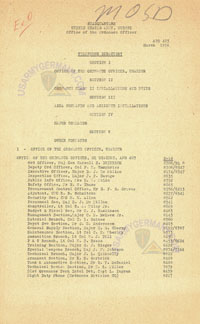










 NATO Strategy Documents
NATO Strategy Documents  Militärfahrzeug Special
Militärfahrzeug Special  War Without Battles cover
War Without Battles cover